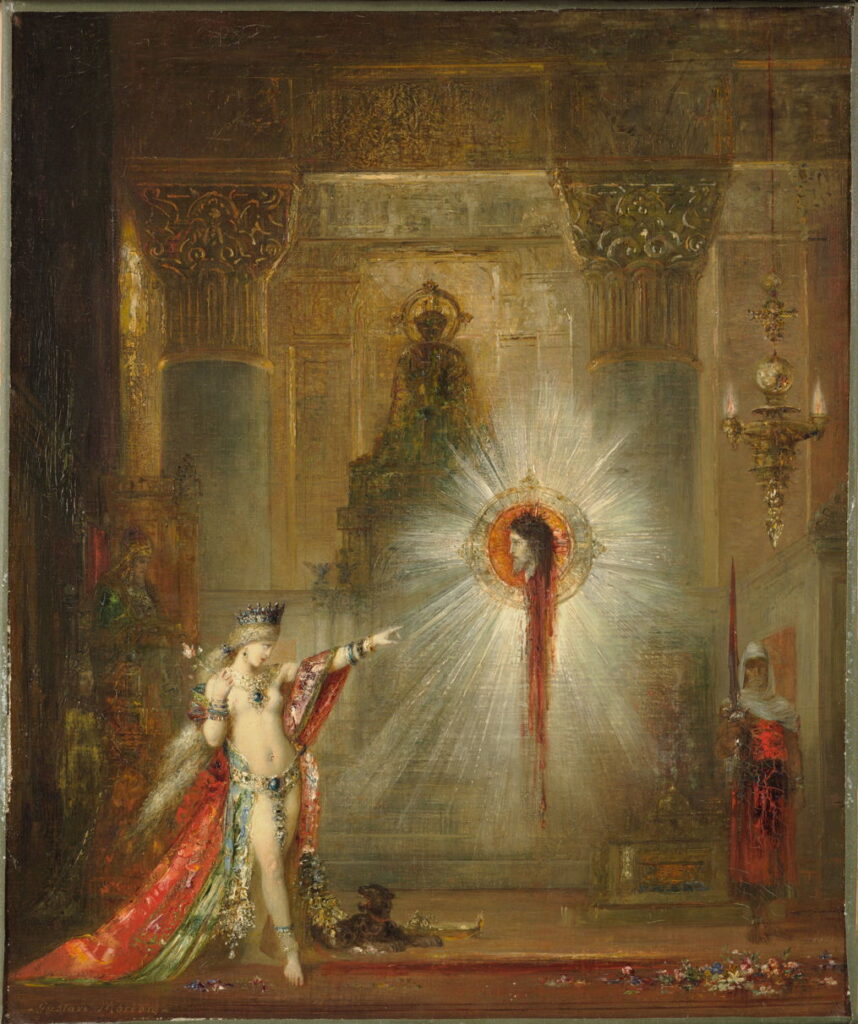Who had John the Baptist killed? 2 Salome

By the middle of the nineteenth century, some ambiguity had been developing in the biblical story of Herod’s party, Salome’s dance, and the execution of Saint John the Baptist. Although the underlying story still puts Herodias as the driver behind John’s beheading, attention had been steadily transferring to Herodias’ daughter, Salome.
Henri Regnault (1843–1871), Salome (1870), oil on canvas, 160 × 101 cm, The Metropolitan Museum of Art (Gift of George F. Baker, 1916), New York, NY. Courtesy of The Metropolitan Museum of Art.
This drift was most apparent in Henri Regnault’s Salome (1870), which caused a sensation when shown at the Salon that year, only a few weeks before France became embroiled in the Franco-Prussian War, in which the artist was killed.
Most unusually, Regnault shows Salome alone, equipped with a short sword with which to behead John, and the large platter to contain his head. She is dressed as an ‘oriental’ (North African) dancing girl, and Regnault had originally intended to make her appear North African too. On her face is a knowing smile, of someone who is about to get exactly what they wanted. This is all implicit, and there is nothing here which directly contradicts the biblical account, or explains why it might be Salome, rather than her mother, who wants John dead.
We don’t know exactly what motivated Gustave Moreau to paint a series of works culminating in the two paintings of Salome he exhibited at the Salon in 1876. He seems to have started work on them just prior to the outbreak of war in 1870, and it may be that his long-standing interest in the femme fatale converged with his reading of Regnault’s Salome.
Moreau developed two different but related scenes in these paintings: one shows Salome as a dancer, and culminated in an oil painting of Salome during her dance in front of Herod, prior to the execution of John; the other shows Salome and the floating, severed head of John. I here concentrate on the latter, as you can read about the other painting here.
Salome Carrying the Head of John the Baptist on a Platter (1876), included in yesterday’s article, seems to have been a starting point for The Apparition.
Gustave Moreau (1826–1898), The Apparition (1875), oil on canvas, 142 × 103 cm , Musée National Gustave-Moreau, Paris. Wikimedia Commons.
This oil study from 1875 takes the central part of Salome and adds the severed head of John, floating in mid-air. Salome is almost more naked than nude, with her jewellery and other adornments, and points accusingly at the head, while holding a lotus flower in her right hand. Herod and Herodias are lost in the shadows somewhere on the left, and John’s executioner stands to the right. Central to the composition, though, is the eye-to-eye confrontation between Salome and the head of John the Baptist. Moreau has moved on from the traditional story about Herodias and her marriage: John’s martyrdom is now about Salome, and she is the author of his execution.
Gustave Moreau (1826–1898), The Apparition (c 1876), watercolour on paper, 106 x 72 cm, Musée d’Orsay, Paris. Wikimedia Commons.
The watercolour version of The Apparition (c 1876) exhibited at the Salon, now in the Musée d’Orsay, is that shown above, and has sadly lost its former rich colours. It adds the details of the cadaveric King Herod sat on his throne, with Herodias at his feet, and the musician who accompanied Salome’s dance is also shown. In the midst of the flowers strewn on the floor is a large bloodstain, from John’s severed neck above, which is still dripping blood.
Gustave Moreau (1826–1898), The Apparition (1876-77), oil on canvas, 55.9 x 46.7 cm, Harvard Art Museums/Fogg Museum (Bequest of Grenville L. Winthrop), Cambridge, MA. Courtesy of Harvard Art Museums.
This slightly later oil version of The Apparition (1876-77), now in the Fogg Museum, gives a better idea of the original effect of Moreau’s watercolour, although the panther has moved across to replace the musician, and the background is quite different.
Moreau’s new story of Salome and the execution of John the Baptist was well-timed. It coincided with a revival of interest in spectacular deaths and gruesome scenes, and the increasingly overt sexualisation which occurred in all the arts towards the end of the nineteenth century.
Maurycy Gottlieb (1856–1879), Salome with the Head of St. John (1877-78), oil on panel, 27.5 × 17.5 cm, Muzeum Narodowe w Warszawie, Warsaw, Poland. Wikimedia Commons.
Maurycy Gottlieb soon showed his Salome with the Head of St. John (1877-78), in which Moreau’s battle of the gazes becomes a loving embrace.
In 1877, Gustave Flaubert published three short stories, including an extended account of the traditional biblical narrative with Herodias at its centre. The British writer Oscar Wilde was introduced to that by Walter Pater (philosophical leader of Aestheticism), and in 1884 Joris-Karl Huysmans’ À rebours was published, a novel including a description of Moreau’s Salome paintings.
Wilde’s one-act play Salome was first published in French in 1891, and was soon translated into English and German. Banned from public performance in Britain, it received its premier in Paris in 1896, but wasn’t performed in public in England until 1931. At the centre of Wilde’s play is the perversion of lust and desire in Salome, best summarised in her words at the end of the play (he calls John the Baptist Jokanaan):
But, wherefore dost thou not look at me Jokanaan? Thine eyes that were so terrible, so full of rage and scorn, are shut now. Wherefore are they shut? Open thine eyes! Lift up thine eyelids, Jokanaan! Wherefore dost thou not look at me? Art thou afraid of me, Jokanaan, that thou wilt not look at me?
If thou hadst looked at me thou hadst loved me. Well I know that thou wouldst have loved me, and the mystery of love is greater than the mystery of death.
Wilhelm Trübner (1851–1917), Salome (1897), oil on canvas, 44 × 36.5 cm, Lentos Kunstmuseum Linz, Linz, Austria. Wikimedia Commons.
Growing decadence in the last years of the century brought increasingly explicit images, such as Wilhelm Trübner’s Salome (1897) with her dressed hitched up to reveal much of her right buttock, but that makes no use of the gaze, so crucial in Moreau’s paintings and Wilde’s play. It was Lovis Corinth who developed that further, in his second painting of Salome, in 1900.
Lovis Corinth (1858–1925), Salome (II) (1900), oil on canvas, 127 × 147 cm, Museum der Bildenden Künste Leipzig, Leipzig. Wikimedia Commons.
The severed head of John the Baptist is at the centre, with Salome leaning over and touching it with her right hand, her bare breasts pendulous over John’s beard. The platter containing John’s head is itself on the head of a slave, who kneels at the feet of the executioner, who stands holding the bloodied sword in his right hand, facing Salome. Salome is staring intently at the lower abdomen of the executioner. Her right hand is stretching open the left eye of John’s head, which appears to be staring up at her.
Behind Salome are two women. The executioner and the young woman at the top right are laughing at one another, but the woman beside her has a serious, almost sad expression, as she stands holding a very large peacock fan. Visible at the top of her clothing, directly below her chin, is the small image of a human skull.
To the lower right, three other figures are partly cropped out: the feet and legs of John’s dead body, which are spattered with blood and wounds, and another slave bent over them to look at the head of an older man.
The chain of gaze here is central to the painting’s narrative: John’s eye stares at Salome, who stares at the executioner’s crotch, who laughs at the young woman at the top right, who laughs back at him. Watching sombre and detached from behind is the figure of death. This is now Wilde’s Salome in paint.
Pierre Bonnaud (1865-1930), Salome (c 1900), oil on canvas, 198 x 141 cm, Musée National Ernest Hébert, Paris. Wikimedia Commons.
Pierre Bonnaud combined the power of gaze with near-explicit nudity in his Salome (c 1900). She has become decadence personified.
Henry Ossawa Tanner (1859–1937), Salome (c 1900), oil on canvas, 116.5 × 89.4 cm, Smithsonian American Art Museum, Washington, DC. Wikimedia Commons.
Despite Henry Ossawa Tanner’s religious paintings, his Salome (c 1900) used new electric lighting effects to make the diaphanous gown of his dancer model more sensuous, and relegated John’s head to a corner of his canvas.
After seeing Wilde’s play performed in Berlin in 1902, Richard Strauss resolved to turn it into an opera. He started work on this in the summer of the following year, and Salome was completed and premiered in 1905. A year later, the dancer and choreographer Maud Allan produced a show called Vision of Salomé in Vienna, featuring a notorious version of the Dance of the Seven Veils, Wilde’s title for the dance of Salome before Herod, also included in Strauss’s opera. The name quickly became a euphemism for a striptease, and the growing popularity of Salome as an erotic figurehead became named Salomania.
Franz von Stuck (1863-1928), Salome (1906), media not known, 114.5 x 92 cm, Staedtische Galerie im Lenbachhaus und Kunstbau, Munich, Germany. Wikimedia Commons.
These are exemplified in Franz von Stuck’s Salome (1906), where John’s severed head is held by a creature in the shadows behind the topless dancer.
Éder Gyula (1875-1945), Salomé holding the severed head of John the Baptist (1907), media and dimensions not known, Palatul Culturii din Târgu Mureș, Romania. Image by Sascha Mauel, via Wikimedia Commons.
Some artists still recognised the power of the gaze, while continuing to push the boundaries of eroticism: this is Éder Gyula’s Salomé holding the severed head of John the Baptist from 1907, in which John’s head becomes Salome’s dancing partner.
Gustav Klimt (1862-1918), Judith II (Salome) (1909), oil on canvas, 178 x 46 cm, Ca’Pesaro, Galería de Arte Moderno, Venice. Wikimedia Commons.
Gustav Klimt’s Judith II from 1909 shows Salome, bare-breasted, with John’s head at the lower right, its eyes closed.
Robert Henri (1865–1929), Salome (1909), oil on canvas, 196.9 x 94 cm, John and Mable Ringling Museum of Art, Sarasota, FL. The Athenaeum.
Strauss’s opera arrived in New York in 1907, and inspired Robert Henri to invite a Mademoiselle Voclexca to perform the notorious Dance of the Seven Veils in his studio. He then interpreted her dance into a series of paintings, including this Salome (1909), in which John’s head has been omitted altogether.
Bela Čikoš Sesija (1864-1931), Salome (1919), oil on canvas, dimensions not known, Galerija likovnih umjetnosti, Osijek, Croatia. Wikimedia Commons.
Painters continued to develop more explicit images of Salome in which sex and death were further entangled. This is Bela Čikoš Sesija’s Salome from 1919.
Julio Romero de Torres (1874–1930), Salome (1926), oil and tempera on canvas, 72 x 92 cm, Museo Julio Romero de Torres, Córdoba, Spain. Wikimedia Commons.
Julio Romero de Torres’ disturbing Salome (1926) took this even further.
In around fifty years, from the appearance of Moreau’s The Apparition at the Salon in Paris, the traditional story of Herodias obtaining her vengeance by exploiting her daughter’s dance before Herod, had been all but forgotten. The martyrdom of the second holiest figure in the gospels had been transformed into a perverse confusion of sex and death. The anonymous daughter of a woman who married her divorced husband’s brother has become the ultimate femme fatale: beautiful, sexy, and dangerous to know.
Most unusually this change in story has largely been triggered and driven by paintings: Moreau’s The Apparition, which influenced Wilde’s play, thus Strauss’s opera, and out to permeate and influence movies, novels, paintings, even people’s fantasies. Stories can be very powerful.
References
Neginsky R (2013) Salome: The Image of a Woman Who Never Was; Salome: Nymph, Seducer, Destroyer, Cambridge Scholars. ISBN 978 1 4438 4621 9.




